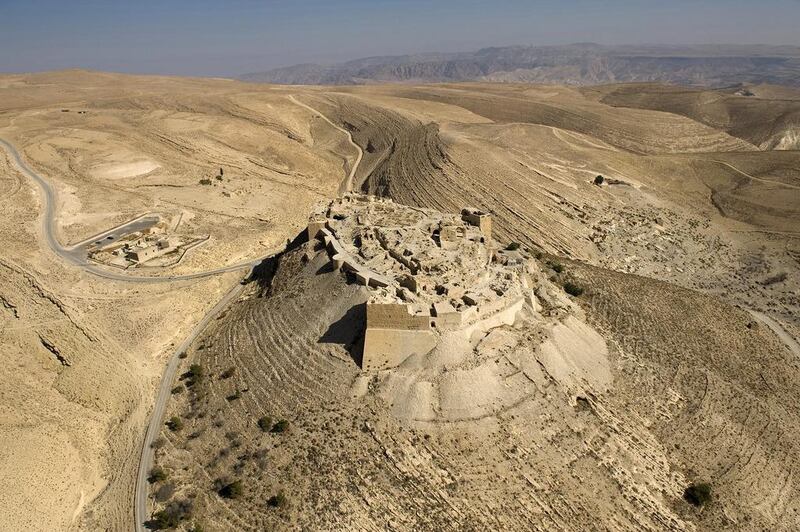QASR BSHIR // The helicopter door opens and Robert Bewley leans out, hundreds of feet above the Hisban Roman ruins near Amman. Feet on the struts, the Oxford University archaeologist begins taking photos as the chopper circles the ancient stones.
Sheep flock far below amid marble columns from 1,700 years ago. After a few minutes, Mr Bewley shouts directions into a radio headset, and the helicopter banks towards another site sitting on a cliff above a major road.
“To discover sites if we were just out on the ground would be really difficult,” Mr Bewley says. “In an hour’s flying we can record between 10 and 20 sites and once they’re recorded through digital photography, that’s a record that will last forever.”
Mr Bewley and his colleague David Kennedy aim to discover and preserve archaeology through a growing archive of sites across the Middle East and North Africa with 91,000 images so far.
While Roman, Ottoman, Byzantine, Nabataean, Neolithic and British imperial sites have been uncovered in the past 19 years, the pair have also revealed both mysterious man-made rock structures and “catastrophic” urban sprawl destroying and threatening sites across the kingdom.
Refugees fleeing wars in the Palestinian territories, Iraq and Syria have decimated Jordan’s land and water resources over the past few decades, Mr Kennedy says.
“I could see the archaeology was disappearing, and one of the things that’s been quite shocking since then is to see that the process is accelerating,” he said. “It’s now at an almost catastrophic level.”
Their photographs show the northern city of Jerash slowly enveloping Roman ruins there. Other photos show site after site bulldozed, roads cut through Nabataean temples and Roman forts, and a Neolithic cemetery ransacked by looters. An Umayyad palace visible one year ago is now gone, razed to make way for an olive orchard.
Destruction of antiquities is clear from the air, but so are 2,000 enormous man-made rock structures once known as “the works of the old men” in Jordan’s bleak basalt desert.
These 4,000 to 9,000-year-old weathered stones blend into the rocky landscape, and lay camouflaged for millennia. Before the invention of flight, famous colonial travellers like Gertrude Bell walked right past them, Mr Kennedy says.
“For all practical purposes they saw nothing,” he says.
British pilots delivering mail between Cairo and Baghdad in the 1920s first noticed the structures starkly contrasting with the pale desert floor. Not knowing what they were, the pilots nicknamed them “kites” after crude children’s drawings. The Second World War halted the photography until Mr Kennedy and Mr Bewley soared over with cameras.
“Just by going up a few hundred feet, we could see that there were literally thousands of kites there,” Mr Kennedy says.
Roughly 4,500 “kites” of regional variety have since been found across the Fertile Crescent in Armenia, Turkey, Syria, Jordan, Egypt, the West Bank, Saudi Arabia and Yemen, according to the Lyon-based Global Kites Project.
“My god, it was just amazing what you cannot see on the ground,” says Gary Rollefson, a professor emeritus at Whitman College who has worked in Jordan since 1978.
“We could tell there were some humps over there, but the distribution or density of these things was just overwhelming.”
Their peculiar geometry – pennants, circles and fans – drew archaeologists like Prof Rollefson to dig in Jordan’s barren eastern desert.
Prof Rollefson has found oak, duckweed, cattails and tamarisk pollen in red mud at a Neolithic site called Wisad Pools. Other archaeologists have found animal bones. The discoveries have led archaeologists to reach a consensus, he says.
“There’s no question, that place was a lot greener than it is today,” Prof Rollefson says. “There used to be a heck of a lot more water than there is today.”
The evidence suggests the kites were massive hunting traps used to corral wild game in a much greener environment. People would drive herds between stone walls that would slowly narrow the running animals into dead-end pits six-feet deep.
“They become like a Safeway meat market,” Prof Rollefson says. “Just leave them down there until you want to eat them.”
At first Mr Kennedy was not allowed to fly when he began the Aerial Photographic Archive for Archaeology in the Middle East in 1978. He spent 25 years collecting aerial photos and old maps before Google Earth made satellite images widespread.
The Aerial Archaeology in Jordan project took to the skies in 1997 when the head of the air force, Prince Faisal, brother to King Abdullah II, authorised flights on Jordanian military helicopters.
A decade later, Mr Kennedy and Mr Bewley increased the range and number of flights after receiving grants from the Packard Humanities Institute adding up to US$2.5 million (Dh9.2m).
Mr Bewley said the aerial perspective, even in an age of Google Earth, can inform and lead to new discoveries.
“We frequently find ourselves smiling with delight because you can’t speak very often because of the sound of the helicopter. But as your flying over them you find yourself grinning foolishly because there’s something rather remarkable opening up beneath you going on and on and on into the distance,” Mr Kennedy says.
* Associated Press





